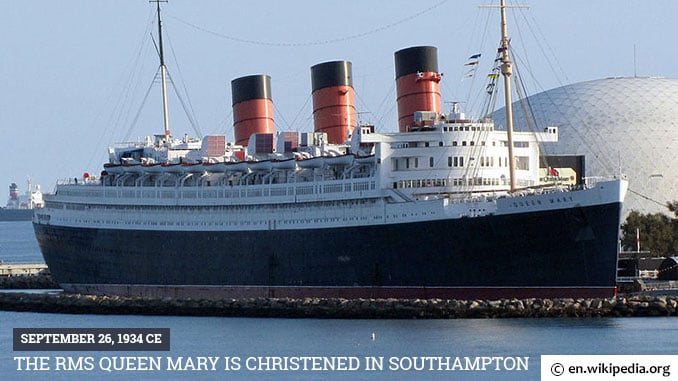After nearly four years of construction and numerous design changes, the RMS Queen Mary received its official christening from her namesake on September 26, 1934. Sliding into the River Clyde in Glasgow, Scotland, the massive Cunard oceanliner took its place as one of the largest ships ever built up to that point — second only to the French SS Normandie. Though small by today’s standards, the ship came to fame for its speed during a three-decade run sailing during peacetime and war. In the mid-1920s, European nations launched a competition to see who could manage to construct the largest commercial vessel on the ocean. As manufacturers in Germany and France attempted more audacious designs with larger and larger proportions, British ship designers naturally sought to find a way to end up on the top of the heap. Thus, White Star Line — which had owned the Titanic — commissioned the 60,000-ton Oceanic in 1928 while Cunard sought plans for a ship coming in at a massive 75,000 tons. Hoping to run two roundtrips a week from Southampton to New York by the middle of the 1930s, Cunard hired John Brown & Company Shipbuilding and Engineering to pull together Hull No. 534 — the Queen Mary’s design name — in Glasgow, Scotland. Having already built the RMS Lusitania, HMS Hood and HMS Repulse, the manufacturer had a reputation for completing large-scale projects on time. Beginning in December 1930, the first pieces of steel were laid for the as-yet-unnamed ship set to be one of the largest in the world. A year later, mired in the Great Depression, Cunard was unable to keep up payments on the project. As traffic slowed in the wake of the world economic meltdown, construction came to a full stop with little possibility of starting again. Petitioning the British Government, the company managed to secure financing for 534 and a sister ship, Hull No. 552 (later the RMS Queen Elizabeth). In limbo for two-and-a-half years, Cunard and White Star merged to form a single company in May 1934. Once the loan had been secured, however, the 42-month construction of No. 534 had resumed in full force. By September 1934, the ship was complete. Featuring an ornate Art Deco interior, the stunning oceanliner came under fire for eschewing a more classical style in favor of the highest fashion of the time. Looking at the exterior, critics found the opposite problem: the Normandie looked state-of-the art instead of like a bigger version of the Titanic or Lusitania. Filled with woods from all over the British Empire, the dining halls and staterooms were some of the most elegant you could find on the ocean. And, as a means to separate the ship from its counterparts sailing from Nazi Germany, a Jewish prayer room was added to the design. Now coming in at 80,744 tons, the ship had gained significant weight from the original blueprints in order to accommodate a variety of modern conveniences — including two indoor swimming pools. The last task on the list would be to name the vessel. According to legend, officials from the Cunard company approached King George V with the hopes of christening the ship Victoria. Telling him they wished to name the hull after “Britain’s greatest queen,” the king obliged, believing they meant his wife, Mary of Teck, instead of his grandmother. Unwilling to disappoint the current queen, the Queen Mary was launched by the queen herself on September 26, 1934. The Queen Mary officially entered service in 1936, capturing the Blue Riband — a prize for the fastest average speed back and forth across the Atlantic Ocean — on its first voyage in August. The ability to cut through the water quickly despite its size would be a great asset. When the ship converted to a troop carrier during World War II, the repainted hull earned the name “Grey Ghost” for its ability to evade German U-boats while delivering as many as 15,000 soldiers from one side of the ocean to the other. Once peacetime returned, the Queen Mary’s expensive fixtures were removed from storage and placed in the grand ballrooms and extravagant dining halls once again. Retired in 1967 as transatlantic cruise traffic plummeted and air travel became more common, the ship made her final voyage from Southampton to rest in Long Beach Harbor in California. Now a museum and hotel, she remains a majestic sight for thousands of tourists every year. Also On This Day:1580 – Sir Francis Drake completes his circumnavigation of the Earth. 1687 – The Parthenon is partially destroyed when Venetian artillery is lobbed at Ottoman Turks stationed in Athens. 1777 – British troops occupy Philadelphia, Pennsylvania during the American War for Independence. 1944 – Operation Market Garden, the Allied attempt to invade Holland and end World War II by Christmas, is repelled. 1959 – Typhoon Vera makes landfall in Japan, killing 4,586 and leaving 1.6 million homeless.
September 26 1934 CE – The RMS Queen Mary is Christened in Southampton
After nearly four years of construction and numerous design changes, the RMS Queen Mary received its official christening from her namesake on September 26, 1934. Sliding into the River Clyde…
